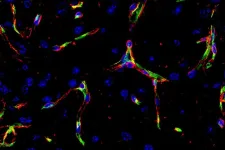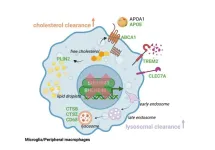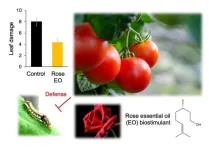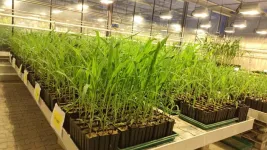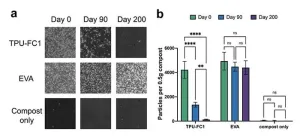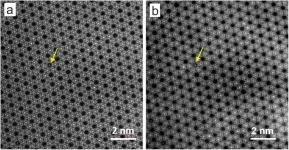(Press-News.org) They published their work on Mar. 15th in Energy Material Advances.
"The development of cost-effective and high-performance RP anode materials for LIBs/SIBs is imperative," said paper author Hailei Zhao, professor with the Beijing Key Lab of New Energy Materials and Technology, School of Materials Science and Engineering, University of Science and Technology Beijing, "Despite RP shows a great potential, the inherent poor electrical conductivity of RP (~10-14 S cm-1) and significant volume changes during charge/discharge processes (> 300%) compromise its cycling stability."
Zhao explained that the poor electrical conductivity and significant volume changes of RP cause substantial electrode polarization, sluggish reaction kinetics, severe electrode pulverization and thus a rapid decay in electrochemical performance.
"Based on these understandings, a great deal of efforts has been dedicated to optimize the RP-based electrode, enhance its electrochemical performance, and facilitate its commercialization." Zhao said.
In a similar approach to other electrode materials with low conductivity and large volume changes, the introduction of functional material with excellent electrical conductivity and mechanical properties is considered a feasible solution to establish a conductive network and provide adequate buffering and protection. This measure is equally effective for RP to construct a stable electrode, but there still have several issues remain to be solved. Zhao and her team reviewed the latest work and outlined main challenges of RP anodes with the corresponding solutions.
"These issues include: (1) the large particle size and limited reactivity of RP, (2) poor intrinsic electrical conductivity and huge volume changes with guest ion insertion/extraction, (3) undesired interfacial instability, (4) chemical stability and oxidation issues, (5) a low mass ratio of RP in working batteries," Zhao said. "These issues are important but easily overlooked. To advance this, we also assess the impact of these aspects on electrode's performance, pros and cons of various strategies to solve these problems."
"We also discusses the future prospects of RP for LIBs/SIBs and aims to provide a different perspective on the challenges that must be overcome to fully exploit the potential of RP and meet commercial application requirements."
Other contributors include Jin Bai, Zhaolin Li, School of Materials Science and Engineering, University of Science and Technology Beijing; Xinran Wang, Chuan Wu, Beijing Key Laboratory of Environmental Science and Engineering, School of Materials Science and Engineering, Beijing Institute of Technology, and Yangtze Delta Region Academy of Beijing Institute of Technology, Jiaxing; Konrad Świerczek, Faculty of Energy and Fuels, AGH University of Krakow, Krakow, Poland.
This work was financially supported by National Natural Science Foundation of China (52074023), Beijing Natural Science Foundation (2222062) and National Key R&D Program of China (2023YFE0119500).
###
Reference
Authors: JIN BAI, ZHAOLIN LI, XINRAN WANG, KONRAD ŚWIERCZEK, CHUAN WU, AND HAILEI ZHAO
Title of original paper: Limitations and Strategies toward High-Performance Red Phosphorus Materials for Li/Na-Ion Batteries
Journal: Energy Material Advances
DOI: 10.34133/energymatadv.0086
Affiliations: 1School of Materials Science and Engineering, University of Science and Technology Beijing, Beijing 100083, China. 2Beijing Key Laboratory of Environmental Science and Engineering, School of Materials Science and Engineering, Beijing Institute of Technology, Beijing 100081, China. 3Yangtze Delta Region Academy of Beijing Institute of Technology, Jiaxing 314019, China. 4Faculty of Energy and Fuels, AGH University of Krakow, Al. A. Mickiewicza 30, 30-059 Krakow, Poland. 5Beijing Municipal Key Lab of New Energy Materials and Technology, Beijing 100083, China.
END
In a Finnish outcrop nestled between some of Northern Europe's oldest mountains, researchers have found traces of a previously hidden part of Earth's crust that points more than three billion years back in time and north towards Greenland.
These traces were found in the mineral zircon, which after chemical analyses, indicated to researchers from the Department of Geosciences and Natural Resource Management that the "foundation" upon which Denmark and Scandinavia rest, was probably 'born' from Greenland approximately 3.75 billion years ago.
"Our data suggest that the oldest part of Earth's crust beneath Scandinavia originates ...
Among the many confounding symptoms in patients recovering from a COVID-19 infection are memory loss and difficulty learning. Yet little is known about the mechanisms of cognitive impairments like these, commonly called brain fog.
In a new study, researchers at the University of Illinois Chicago have identified a mechanism that causes neurological problems in mice infected with SARS-CoV-2, the virus behind COVID-19. The researchers also found a treatment that helped prevent these changes. Sarah Lutz, assistant professor of anatomy and cell biology in the College of Medicine, led the research, ...
Highlights:
Legionnaires’ disease is a rare and dangerous respiratory tract infection.
Diagnoses and surveillance usually require culturing isolates.
A new study shows how whole genome sequencing could be used when culturing isn’t an option.
The work points to new avenues for public health surveillance of infectious diseases.
Washington, D.C.—Legionnaires’ disease (LD), a rare and severe type of pneumonia, is a respiratory infection caused by species of Legionella bacteria. One of the most accurate ways to diagnose LD is to perform culture on samples from a patient’s lower respiratory tract, but those samples are difficult ...
New York, NY [March 21, 2024]—Using novel genetic and genomic tools, researchers at the Icahn School of Medicine at Mount Sinai have shed light on the role of immune cells called macrophages in lipid-rich tissues like the brain, advancing our understanding of Alzheimer’s and other diseases. The study, published in the March 6 online issue of Nature Communications [DOI: 0.1038/s41467-024-46315-7], represents a step forward in understanding immune cell regulation and its impact on disease progression.
The researchers initially studied genes controlling macrophages, also referred ...
Plants-derived essential oils (EOs) find applications in various industries, such as detergents, cosmetics, pharmacology, and food additives. Moreover, EOs have an exceptional safety profile, and their numerous bioactivities greatly benefit human health. Beyond these benefits, EOs have also been found to illicit insect-repellent responses by inducing neurotoxic effects.
Terpenoids are abundant in plant EOs and have garnered widespread attention as they can regulate plant defense responses by regulating the expression of defense genes. For example, soybean and komatsuna plants, when grown near mint, experience a significant improvement in defense properties ...
Contact:
Jillian McKoy, jpmckoy@bu.edu
Michael Saunders, msaunder@bu.edu
##
Identifying genetic variants and the role they play in predisposing people to Alzheimer’s disease can help researchers better understand how to treat the neurodegenerative condition for which there is currently no cure. A new study led by Boston University School of Public Health (BUSPH) and UTHealth Houston School of Public Health has identified several genetic variants that may influence Alzheimer’s disease risk, putting researchers one step closer to uncovering biological pathways to target for future treatment and prevention.
Published in the journal Alzheimer’s ...
In order for plants to grow, they absorb water and nutrients through their roots. In doing so, they rely on tiny helpers: bacteria and fungi in particular are found in a thin layer around the roots. These microbes also ward off organisms that are harmful to the plant, just as the "microbiome" in the human gut helps determine whether we fall ill or stay healthy.
An international research team led by the University of Bonn and with the participation of the IPK Leibniz Institute has now demonstrated on maize plants that the genetic make-up of the host plant has a significant influence on the composition of the root microbes. "It was shown ...
Reduced snow cover and shifting vegetation patterns in the Alps, both driven by climate change, are having major combined impacts on biodiversity and functioning of ecosystems in the high mountains, according to new research published today.
Mountain ranges covering vast areas of the world are warming much faster than surrounding lowland areas, triggering huge reductions in snow cover and rapid upward movement of dwarf-shrubs, such as heather.
Scientists at The University of Manchester have found that these changes are disrupting the timing of crucial alpine ecosystem functions performed by ...
Microplastics are tiny, nearly indestructible fragments shed from everyday plastic products. As we learn more about microplastics, the news keeps getting worse. Already well-documented in our oceans and soil, we’re now discovering them in the unlikeliest of places: our arteries, lungs and even placentas. Microplastics can take anywhere from 100 to 1,000 years to break down and, in the meantime, our planet and bodies are becoming more polluted with these materials every day.
Finding viable alternatives to traditional petroleum-based plastics and microplastics has never been more important. New research from scientists ...
In addition to their main components, the properties of crystalline and nanoporous materials often depend crucially on guest atoms or ions that are embedded in the tiny pores of their lattice structure. This applies to high-tech materials used in sensor or separation technology as well as to natural materials. The bluish gemstone aquamarine, for example, would be colourless without such guest components. Determining the type and position of guest components is difficult, as many materials react sensitively to the radiation emissions ...

